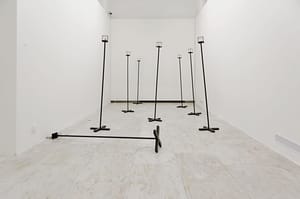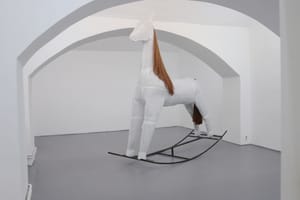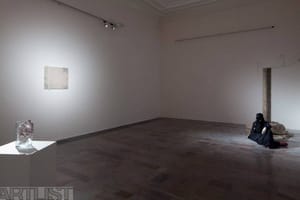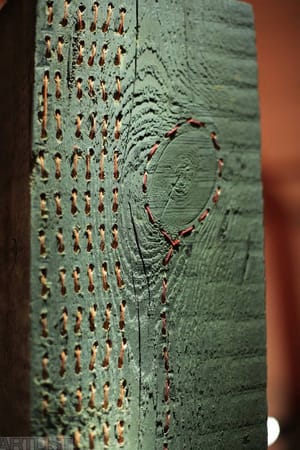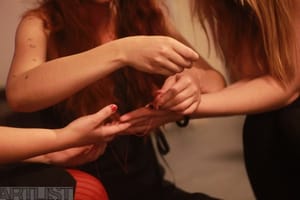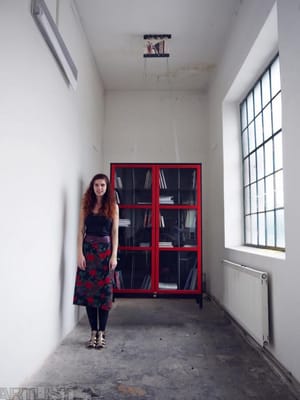- First Name
- Karíma
- Surname
- Al-Mukhtarová
- Born
- 1989
- Birth place
- Praha
- Place of work
- Praha
- Website
- https://www.karimalovesyou.com/
- CSU Library
- ↳ Find in the catalogue
About artist
So far most of Karíma Al-Mukhtar’s creative work has been predominantly in the fields of installation and performance. Thematically, her work often examines various myths from the domains of the so-called “urban legends” and physical phenomena. Although in this sense much of her work may seem closely related to a type of magic trick on the one hand, and laboratory or social research on the other hand, usually the outcome is not a point or piece of information, but a visual situation. The artist’s articulation of object, process and social situations results in forms presented in a sensitive way, which can be, for a great part, attributed to the influence of her teacher Jiří Kovanda. At the same time, by basing her activities on the cultural codes of superstition and scientific research, and recently by examining her relationship to Arab culture, the artist has been shifting the meaning of this inherited visual language into a newly articulated context.
The process that begins with her intention and results in the final form is particularly manifested in the artist’s performances. In Feel the Jump (2011) she reconstructed the scene of a fall, derived from Yves Klein’s famous action, into a static moment. Using physical effort she held herself on the verge of a free fall from a plinth placed in the gallery. Her work here became the embodiment of the moment of surrender to gravitational force stretched into a long time interval. In another work,, titled Between (2013), she performed subtle physical intervention by sewing together the fingertips of two friends sitting opposite each other, using a needle and thread on their skin. Here she created a corporeal situation as well as a parable of social relationships.
Al-Mukhtar further touched upon the above-mentioned world of superstitions and myths in her 26 works called 28X1509/2011/12 (2011-12) in which, as part of her research, she undertook to verify diverse urban legends. The cycle primarily consists of installations conceived as tests of the functionality of a given principle that ultimately represents autonomous art solutions. Among these works we find a bookshelf full of books hanging in the air held only by the friction of the pages of two interleaved books (Project nr. 11, 2012), or some smaller projects where Mukhtar took advantage of the unexpected effects brought about by a pair of intersecting objects. For instance, in her work Nr. 21 (2012,) she made a contrast of a fresh tomato interwoven with cooked spaghetti. As evident from the last-mentioned work, the realizations from this cycle often represented ephemeral outcomes, leading to an aesthetic conclusion instead of an empirical one.
In many of her recent works the artist utilizes the results of the above research in projects where her previous position of a “magician” shifts to bringing about an effect using the contrast of materials and unusually applied techniques. The aesthetic and semantic values of such confrontations take over the fascination aroused in the viewer by a “magic trick”. In her series Exception (2013-4) the leading role belongs to cross-stitching, uncharacteristically applied to wood where she created a number of wooden posts with embroidered patterns. In another part of this series, the artist experimented with embroidery in the human skin, which is documented by photographs.
In the exhibition project Dear Valued Customers (2014), the artist’s interest in embroidery was demonstrated in relation to the phenomenon of Arabic ornament, applied at an exhibition on a mannequin dressed in a burqa. In the context of the artist’s work, we can perceive this connection as work with a specific handicraft, but also as a non-dogmatic commentary of contemporary multiculturalism issues. Instead of pronounced theories, we are addressed here by a purely visual situation carrying a message about another culture by using its forms.
Karíma Al-Mukhtar’s work balances on the border of aesthetics of object relations, process experiments and playing with cultural codes. It is precisely this marginal position, where visual art does not stiffen in its petrified form, performance does not get lost in an expressive gesture, and playing with meanings does not occlude objectivity, which is perhaps this artist’s powerful foundation.
- Author of the annotation
- Viktor Čech
- Published
- 2015
CV
Studium:
2016–2018
Ateliér intermediální tvorby I./ Mileny Dopitové, AVU2015–2016
Ateliér intermediální tvorby II. / Škola Dušana Záhoranského a Pavly Scerankové, AVU2014
Ateliér Jiřího Příhody, AVU, Praha2012–2014
Ateliér Jiřího Davida, VŠUP, Praha2010–2012
Ateliér Jiřího Kovandy, Fakulta umění a designu UJEP, Ústí nad Labem2009–2010
Ateliér Pavla Kopřivy, Fakulta umění a designu UJEP, Ústí nad LabemStáže, tvůrčí pobyty
2014 Jiří Švestka Gallery, Berlin, Německo
2011 Graphic design a TV illustration, KyAMK Univ. of Applied Sciences, Kouvola, FinskoOcenění
2013 Winner of Essl Art Award CEE 2013 pro Českou republiku
2011 Ateliérová cena v ateliéru Jiřího Kovandy
Exhibitions
- Solo exhibitions
-
2020
Connection Almost Found, Galerie města Třince, Česká republika
The State of Being in Between s (Maud Kotasová), GAVU Cheb, Česká republika
Juxtaposition (s Martin Pondělíček), Photoport Bratislava, Slovenská republika
The Different Story, Dětská galerie Lapidárium, Broumov, Česká republika
2019
I'm not what I seem, White Pearl Gallery, Praha, Česká republika
2018
Inner Feeling, Art Space Nov, Pardubice, Česká republika
2017
The Rooms, Futura Gallery, Praha, Česká republika
2016
I don't agree with myself, Jiri Svestka Gallery, Berlin, Německo
2015
Dear Valued Customers, GHMP, Praha, Česká republika
Thirteen Joints, Galerie Ferdinanda Baumanna, Praha
Asi přijde i Zdislav (s Davidem Helánem), Galerie Klubovna, Brno (performance)
2014
Na Okraji, Galerie Prokopka, Praha, Česká republika
Kouzelník (v rámci projektu Je ne travaille jamais), INI Gallery, Praha
Dear Valued Customers, Galerie Hlavního města Prahy - StartUp, Praha
2013
Needlework (performance), Galerie NoD, Praha, Česká republika
Skoro drama, Avoid Floating Gallery, Praha, Česká republika
2012
Strč prst skrz ..., AM180 Gallery, Praha, Česká republika
Jarní úklid, galerie Altán Klamovka, Praha, Česká republika
Hledání jehly v kupce sena, Galerie Umakart, Brno, Česká republika
2011
And Winner is..., Galerie m.odla, Praha
- Group exhibitions not included in ARTLIST.
-
2020
Radikální ženy, DSC galerie, Praha, Česká republika
Viděné Formy,Galerie Kampus Hybernská, Praha, Česká republika
2019
Jiné hlasy, Jiné pokoje, Galerie města Plzeň,Plzeň, Česká republika
2018
Future Ready, Kampus Hybernská, Praha, Česká republika
Pocta Suknu, 8smička, Humpolec, Česká republika
Perlorodky, White Pearl galerie, Praha, Česká republika
2017
Rozhněvaná planeta, NTK galerie, Praha, Česká republika
Vlákna, klubka, tkaniny, Oblastní galerie města Jihlava, Jihlava, Česká republika
2016
Movere, Dům Umění města Brno, Brno, Česká republika
Macochismus, Městská galerie Blansko, Blansko, Česká republika
Syntax Error/Vorspiel Transmediale 2016, Greenhouse Berlin, Berlin, Německo
2015
Hlad - festival performance, Galerie Ferdinanda Baumanna, Praha
Šité na míru: Karíma Al-Mukhtarová, David Helán, Matěj Smrkovský, Galerie Aula, Brno
Možná příjde i Zdislav, Klubovna, Brno, Česká republika
PALS festival, Fylkingen, Stockholm, Švédsko
The body of the model, Berlinský Model, Praha, Česká republika
2014
ABOVE THE ROOFS OF BERLIN, Olivaer Platz, Berlin, Německo
Alotrium, U Dobrého pastýře, Brno, Česká republika
2013
Transcending Cultures – ESSL ART AWARD CEE 2013 , Essl Museum, Klosterneuburg, Rakousko
Hunky Dory, Karlins Studios, Praha, Česká republika
ESSL ART AWARD CEE 2013, Nominees’ Exhibition,galerie Futura, Praha, Česká republika
Sochař nebo zahradník, Galerie Hluboká, Hluboká, Česká republika
2012
Co si počnem?, 1. Patro galerie, Praha, Česká rep.
Nezávislí pozorovatelé, Karlin Studios, Praha, Česká republika
Concentrado V. “A4”, APIS Gallery, Rio de Janeiro, Brazílie
Nezvaný host, Chodovská tvrz, Praha, Česká republika
Posun o 90°, NoD Gallery, Praha, Česká republika
Zlatý déšť, galerie Mumie, Ústí nad Labem, Česká republika
2011
Kukačka Festival, Ostrava, Ostrava, Česká republika
Transparent Refractions, TamTam Gallery, Berlin,Německo
Videokemp , Dům Umění, Brno, Česká republika
Art Has No History, Karlin Studios, Praha, Česká republika
Silk Road Project, Ústí nad Labem/Kazahkstan, Ústí nad Labem/Kazahkstan
Květy Zla, Prague is Great City, Baumann Gallery, Praha, Česká republika
Clean Air, Galerie Mumie, Ústí nad Labem
2010
Ospalá díra, NoD Gallery, Praha, Česká republika
Making Worlds, Emil Filla Gallery, Ústí nad Labem, Česká republika
2009
Via Lucis, SGVU, Litoměřice
- Other realisations
kurátorská činnost:
2015
Manifestation of Medium - Petr Krátký, Viktor Takáč, Bonobo First Floor, Berlin2014
Quando sorge la luna - Anežka Hošková, Lucie Mičíková, Bonobo First Floor, Berlin2012
DRÖMMAR/Markéta Vlčková, Galerie Prokopka, Praha
Posun o 90°, Galerie NoD, Praha (s Viktorem Čechem)2012–13
Spolukurátorka Galerie Altán Klamovka2011–2012
Spolukurátorka galerie I.D.A., Praha
Monography
- Articles
2015
Čech, Viktor: Odpařující se konceptuálno, aneb o současné situaci výtvarnosti nad třemi příklady, Artalk.cz, publikováno 10.2.20152013
Čech, Viktor: Essl Art Award CEE 2013, Časopis Ateliér č.13/2013, s.162011
Ledvina, Josef: Výtvarnost / konceptualita, Časopis Ateliér č.12/2011, s.4



